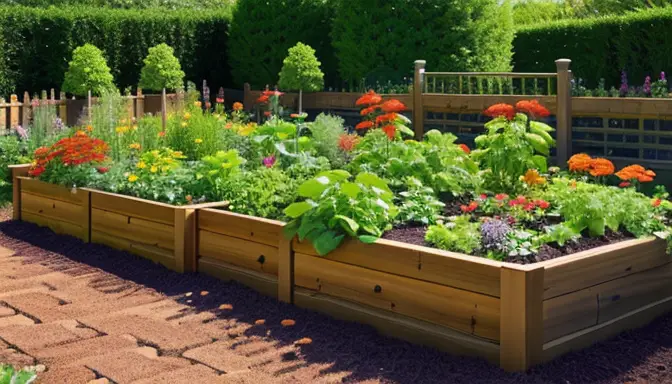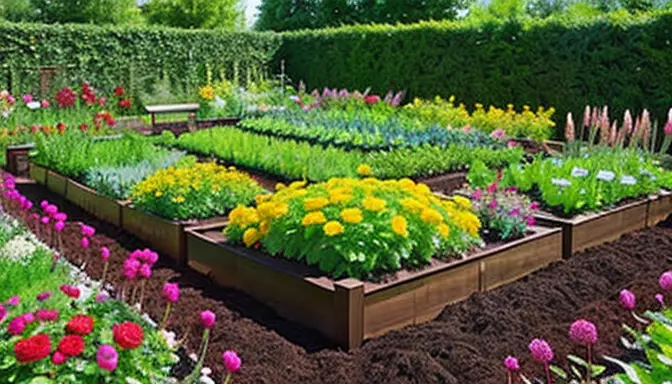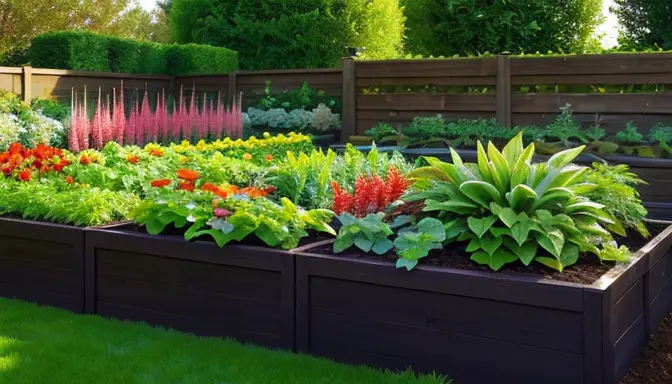
Lining raised beds with materials like plastic or landscape fabric can help retain moisture, prevent soil erosion, and create a barrier against weeds. However, improper drainage and potential chemical leaching are concerns to ponder.
When considering using liners, one must weigh the benefits of weed control against the risks of restricted root growth. It’s like trying to decide if you should wear gloves to protect your hands while gardening or embrace the earth with bare fingers. Both have their merits, but finding the right balance is key to a flourishing garden.
Opting to forgo liners in raised beds promotes natural drainage and allows for better aeration of the soil. Yet, this approach may lead to quicker soil drying and increased weed growth if not managed effectively.
Imagine your raised bed as a mini ecosystem, where the soil breathes freely without any synthetic barriers. It’s like giving your plants a chance to dance barefoot in the rain instead of wearing rubber boots. Sometimes, a little messiness is just what nature ordered.
When choosing a liner for your raised bed, consider factors such as permeability, durability, and environmental impact. Selecting a liner that balances water retention with drainage is crucial for plant health.
Loading... Seconds Left for
Miniature Orchid Terrarium Gallery!

It’s like choosing the right outfit for your garden – you want something that looks good, feels comfortable, and doesn’t suffocate your plants. After all, nobody likes a soggy root or a fabric that unravels at the first sign of rain.
The environ
mental repercussions of using liners in raised beds cannot be ignored. Ensure that the materials you choose are eco-friendly and do not introduce harmful chemicals into the soil, affecting plant growth and surrounding ecosystems.
Just as we strive to reduce our carbon footprint in daily life, our gardening practices should also aim to leave a positive impact on the planet.
Think of your garden as a sanctuary for not just your plants, but for all the critters and microbes that call it home..
Embarking on a do-it-yourself liner project can be a rewarding endeavor, but commercial options offer convenience and reliability. Evaluate your priorities and skills to determine the best approach for your raised bed.
It’s
like deciding between baking a cake from scratch or picking one up from the bakery – both can result in a delicious treat, but the path you choose depends on your time, resources, and baking prowess. Whichever route you take, the end goal is a garden that flourishes like a well-risen soufflé.
Achieving the perfect moisture balance in lined raised beds requires vigilance. Regularly monitor soil moisture levels and adjust watering practices accordingly to prevent issues like waterlogging or drought stress in your plants.
Think of your plants as thirsty guests at a garden party – you want to make sure they have just the right amount of refreshment, not drowning in a flood or gasping for a drop. After all, happy plants make for a lively and vibrant gathering in your garden.
For those o
pting to skip liners in raised beds, strategic planning is key. Implement techniques such as mulching, companion planting, and proper spacing to maximize the benefits of a liner-free approach while minimizing challenges.
Picture your garden as a harmonious orchestra, where each plant plays a unique melody that blends together in a symphony of colors and scents. By orchestrating your garden with care and attention, you can create a masterpiece that sings with the beauty of nature.
The Case for Liners
In the intriguing world of horticulture, the eternal debate on whether to line raised beds continues to captivate the minds of gardening aficionados. Let’s embark on a journey to unravel the mysteries and complexities surrounding the use of liners in raised bed gardening.
Lining rais
ed beds with materials like plastic or landscape fabric serves as a shield, guarding against the forces of nature. Moisture retention, soil erosion prevention, and weed suppression are the noble tasks bestowed upon these humble liners. However, a shadow of doubt looms over the horizon, whispering tales of improper drainage and the ominous specter of chemical leaching. As we tread this path of contemplation, let us not forget the delicate balance we must strike between protection and peril.
Venture forth, dear gardener, into the realm of liners, where decisions hold the weight of a watering can and the promise of flourishing greenery. Let us navigate the maze of choices with wisdom, for in the garden of raised beds, every liner tells a story.

Going_Au_Naturel_No_Liners">Going Au Naturel: No Liners
In the realm of raised bed gardening, the decision to skip liners can be a bold choice that aligns with nature’s rhythms.
Embracing the raw essence of the soil, opting out of synthetic barriers opens up a world of possibilities for your plants to thrive organically..
Without the confines of liners, the soil breathes freely, allowing roots to explore and establish themselves deeply. However, this newfound freedom comes with responsibilities. Careful monitoring of moisture levels becomes paramount, as the absence of liners means a delicate balance must be maintained to prevent parched earth or waterlogged roots.
Considerations for Liner Selection
In the intricate world of raised bed gardening, the choice of liner material can make or break your botanical haven.
Permeability, durability, and environmental impact are like the three musketeers guiding you towards liner enlightenment..
Picture this: your liner is the superhero cape, protecting your plants from the villains of water imbalance and soil erosion. But beware, choose wisely, for not all capes are created equal!
Let’s
dive deeper into the rabbit hole of liner selection. Imagine you’re on a quest for the Holy Grail, except in this case, it’s the Holy Liner. Permeability, the ability of the liner to let water flow freely like a babbling brook, is paramount. Durability, like the strength of a warrior facing the elements, ensures your liner stands the test of time. And environmental impact, the footprint you leave on Mother Earth, should be as light as a butterfly’s touch. Choose your liner wisely, dear gardener, for it holds the key to a flourishing paradise or a botanical disaster!
Now, as you stand at the crossroads of liner decision-making, remember this: a liner is not just a piece of material; it’s a guardian of your green kingdom. Balance is the name of the game here, my fellow plant enthusiast. Find a liner that dances gracefully between water retention and drainage, like a botanical tightrope walker. Your plants will thank you, the soil will sing your praises, and you’ll bask in the glory of a well-chosen liner, knowing you’ve made a decision worthy of a horticultural hero!

Environmental_Impact_Assessment">Environmental Impact Assessment
In the world of plant nurturing, the eternal dilemma of whether to dress raised beds sets the stage for a botanical drama. Let’s explore the virtues and vices of embracing liners in the realm of raised bed cultivation.
Choosing the au naturel route for your raised beds is like letting your plants dance freely in the rain. Embracing the raw earth beneath without any artificial barriers can lead to a symphony of roots intertwining with the soil, but beware of the weeds lurking in the shadows.
When it comes to selecting the perfect outfit for your raised bed, ponder upon the qualities of the liners available. A balance of breathability, sturdiness, and eco-friendliness is essential to ensure a harmonious coexistence between your plants and their bedding.
The repercu
ssions of dressing your raised beds are as serious as a caterpillar contemplating its transformation into a butterfly. Ensure that the materials you choose are like friendly garden fairies, sprinkling magic without harmful chemicals that could disrupt the delicate balance of nature.
Deciding between a homemade liner or a store-bought one is akin to choosing between baking a cake from scratch or grabbing a slice from the bakery. Evaluate your skills and aspirations to determine the path that will lead your plants to flourish with joy.
Balancing moisture levels in your raised beds is like conducting a symphony, where water plays the role of the conductor. Regularly check the soil’s hydration status to keep your plants from drowning or thirsting for life.
For those b
rave souls venturing into liner-free territories, strategic planting is the key to a bountiful
harvest. Implement techniques like mulching and companion planting to create a harmonious ecosystem where plants thrive like a botanical orchestra.
DIY Liners vs. Commercial Options
In the realm of horticulture, the question of whether to line raised beds often sparks heated discussions among enthusiasts. Let’s delve into the pros and cons of using liners in raised bed gardening.
Lining raised beds with materials like plastic or landscape fabric can help retain moisture, prevent soil erosion, and create a barrier against weeds. However, improper drainage and potential chemical leaching are concerns to ponder.
Opting to f
orgo liners in raised beds promotes natural drainage and allows for better aeration of the soil. Yet, this approach may lead to quicker soil drying and increased weed growth if not managed effectively.
When choosing a liner for your raised bed, consider factors such as permeability, durability, and environmental impact. Selecting a liner that balances water retention with drainage is crucial for plant health.
The environmental repercussions of using liners in raised beds cannot be ignored. Ensure that the materials you choose are eco-friendly and do not introduce harmful chemicals into the soil, affecting plant growth and surrounding ecosystems.
Embarking o
n a do-it-yourself liner project can be a rewarding endeavor, but commercial options offer convenience and reliability.
Evaluate your priorities and skills to determine the best approach for your raised bed.
Achieving the perfect moisture balance in lined raised beds requires vigilance. Regularly monitor soil moisture levels and adjust watering practices accordingly to prevent issues like waterlogging or drought stress in your plants.
For those opting to skip liners in raised beds, strategic planning is key. Implement techniques such as mulching, companion planting, and proper spacing to maximize the benefits of a liner-free approach while minimizing challenges.
![]()
ng="async" src="https://plantandseedguide.com/wp-content/uploads/2024/04/to-line-or-not-to-line-raised-bed-debate_6.png" alt="Maintaining a Balanced Moisture Level" />
Maintaining a Balanced Moisture Level
As we delve into the intricate world of raised bed gardening, the quest for achieving an optimal moisture balance becomes paramount.
Regularly monitoring the soil moisture levels in your raised beds is akin to tending to a delicate ecosystem, where the harmony between water and roots must be carefully preserved..
To prevent the dreaded scenarios of waterlogging suffocating your plants or drought stress leaving them parched, vigilance is key. Adjusting your watering practices with precision and care can mean the difference between thriving greenery and a wilting disappointment. Remember, a happy plant is a hydrated plant!
In this jou
rney of moisture management, consider yourself a moisture maestro, orchestrating the symphony of hydration within your raised beds. Let your plants sing with joy as they bask in the ideal moisture levels, nourished and content.
Expert Tips for Liner-Free Success
When venturing into the realm of raised bed gardening without the confines of liners, one must tread carefully yet confidently. Implementing strategies that enhance the natural ecosystem of your garden is paramount. Consider the art of mulching, a practice that not only retains moisture but also adds a touch of aesthetic appeal to your green oasis. Companion planting, the age-old tradition of pairing plants for mutual benefit, can be your garden’s best-kept secret .
Furthermore, proper spacing between plants is akin to giving each botanical resident its personal space to thrive and flourish.
Remember, in the world of horticulture, a little breathing room can go a long way! Embrace the quirks and intricacies of a liner-free approach, and watch as your garden transforms into a harmonious symphony of biodiversity ..
In the purs
uit of a liner-free paradise, remember that challenges may arise, but with a touch of creativity and a sprinkle of determination, you can conquer any obstacle that comes your way. Stay rooted in your passion for gardening, and let nature be your
guide as you embark on this exciting journey of exploration and growth .
Frequently Asked Questions
- Are liners necessary for raised beds?
Liners are not always necessary for raised beds. The decision to use liners depends on factors such as drainage, weed control, and personal preference.
- What are the benefits of using liners in raised beds?
Using liners can help retain moisture, prevent soil erosion, and act as a barrier against weeds. However, it’s essential to consider potential drawbacks like improper drainage and chemical leaching.
- How do I choose the right liner for my raised bed?
When selecting a liner, consider factors like permeability, durability, and environmental impact. Finding a balance between water retention and drainage is crucial for the health of your plants.
- ong>What are some alternatives to using liners in raised beds?
Alternatives to using liners include strategic mulching, companion planting, and proper spacing to promote natural drainage and weed control in raised beds.
Hello, I'm Katie Owen! I am the voice behind "plantandseedguide," inviting you on a journey through the enchanting world of greenery. The magical beauty of nature and the fascinating realm of plants have always captivated me, leading me to this space.
Latest posts by Katie Owen
(see all)NTENT END 1 -->



